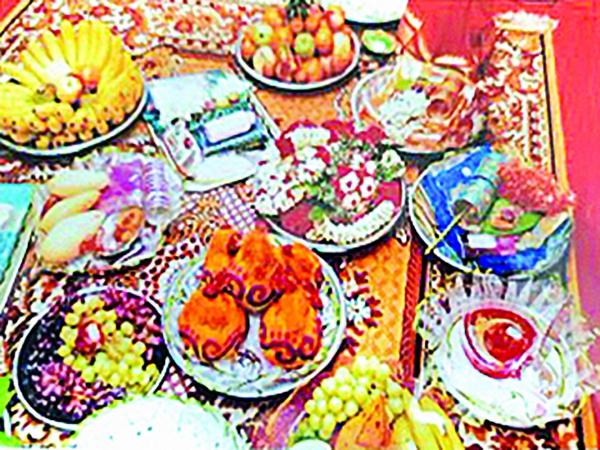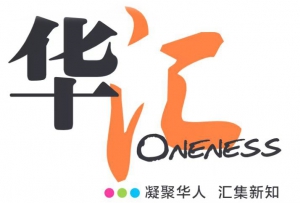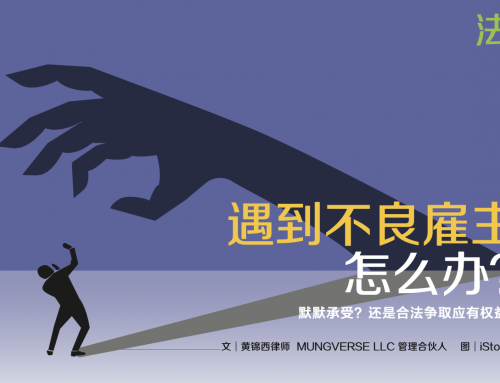印度女孩庆初潮
抹檀香膏,洗姜黄浴,穿半纱丽,不能接触男性。
文| Sukanya Pushkarna (印度妇女协会前会长) 图| 作者提供
从月经节说起
在印度东北部的阿萨姆邦,每年6月会在古老的卡玛加(Kamakhya)寺庙举行生育节或称月经节,庆祝者以女性居多。
这个节日也被称为Ambubachi、Ambubashi或Ameti,与印度东部盛行的密宗母神崇拜相关。人们在一年一度的生育节聚集几天。在集会期间,寺庙会关闭三天,因为人们认为女神在月经期间需要休息。期间信徒会遵守一些限制,例如不做饭,不祈祷或阅读圣书,不做农活等。在这三天里,女神被放在一块红布上,象征她的月经。
三天后,卡玛加女神沐浴并进行几次仪式,以确保女神处于纯洁状态。然后神殿的大门重开。第四天,信众可以进入寺庙拜卡玛加女神,有些信徒也希望获得被认为是吉祥的部分红布。
在东部的奥里萨邦,也有一个节日庆祝母亲女神布德维(大地女神)的月经,相信她会使土地肥沃。这本质上是一场农业庆典,显然印度传统将月经视为生育能力的标志,并隆重庆祝。
初潮=适婚
印度的成人礼主要针对女孩,庆祝她的初潮,在印度旧社会也宣告她已到了“适婚年龄”。操办仪式的包括女孩的舅舅、舅母,或姑姑、姑丈,因为女孩可能成为他们的准媳妇。因此女孩收到的礼物也包括金饰,以示隆重。

女孩的亲人赠送的礼物
印度北部似乎没有正式的成人礼,但印度南部的大部分地区,包括农村和城市,以及阿萨姆邦和奥里萨邦的大部分地区,成人礼是女孩进入青春期的标志。
大多数成人礼包括要求刚来月经的女孩“隐居”。每天给她喂食营养食品以维护生育力,在奇数天给她按摩油和特殊沐浴(这因社区和地区而异)。在印度的许多社区,姜黄酱被涂抹在女孩身上,然后在青春期开始后的第七或第九天,会有一个净化浴,之后会举行庆祝活动,邀请家庭成员和亲友出席。庆祝成人礼的女孩身穿传统服装,手上和脚上戴着首饰,并涂上指甲花。亲戚会给她送礼物,尤其是祖父母和舅舅、舅母。
女孩在月经期间,一般不允许去寺庙、做祈祷仪式和阅读圣书。
演变成盛大派对
移居世界各地的印度家庭,不少仍保留传统,举办盛大的成人礼派对来纪念女孩的初潮。我接触的留美婆婆记得她的初潮是一件严肃但不是特别隆重的事。她原本住在印度安得拉邦的一个村庄,至今仍保存姑姑和姑丈送她的黄金首饰。她的女儿搬到一个大城镇,只办了非常简单的纪念初潮仪式。
至于在美国长大的孙女辈,则经历了最精心的庆祝活动。在遵循仪式的同时,似乎有一种炫耀的倾向,非常重视举行仪式的场地,仪式上的穿着、食物和受邀者。
印度移民似乎也庆祝男孩的成人礼。和女孩相比,男孩的仪式简单多了,一般是在男孩15岁时举行。当天上午是宗教仪式,下午邀亲友参加宴席。男孩会收到亲友赠送的礼物,但不像女孩有那么多的礼物。男孩会在仪式上穿着成年男子的正式服装,象征需要负起成人的社会责任。
移居新加坡已有三代的泰米尔家族也一直保留这个传统,并隆重举行,隆重程度犹如一场小婚礼。遵循的仪式包括女孩的舅舅和家人的积极参与。
女孩成人礼有什么?
1. 穿半纱丽
在南印度卡纳塔克邦,成人礼被称为langa Voni或半纱丽*庆祝活动。女孩穿上舅舅和舅母赠送的半纱丽或一条遮蔽上半身的围巾,并在婚前一直都穿半纱丽,直到在婚礼上才最终穿上传统的纱丽。有些地方,女孩会在仪式的前部分穿着一件新的langa(短上衣和长裙),然后在仪式的后半部穿上舅舅和舅母送给她第一件半纱丽 。
2. 姜黄沐浴
也是在印度南部的泰米尔纳德邦,则有一个被称为 Manjal Neerattu Vizha 的姜黄沐浴仪式,邀请女孩的亲戚、朋友和邻居参加。女孩的舅舅会用椰子、芒果和印楝叶,为女孩建造小屋或kudisai。女孩在姜黄水中沐浴后,留在kudisai。小屋里放着金属扫帚,还有美味的传统美食。
3. 涂抹檀香膏
至于在印度东南部的安得拉邦,成人礼被称为“Peddamanishi Pandaga”。第一天,除母亲外,五名亲戚中的妇女为女孩洗澡。在最后一天的仪式中,女孩需涂抹檀香膏。女孩的叔叔也会赠送像纱丽、珠宝和其他实用品之类的礼物。
4. 不能接触男性
在人文圣地喀拉拉邦,只有一些社区有宣布女孩进入青春期的仪式Thirandukalyanam,是一个为期四五天的庆祝初潮仪式。前三四天不能被男性看到,只能接触女亲戚。“隐居”期间需遵守严格的饮食,之后会被打扮成像新娘一样,接受村民的祝贺。然而这种仪式已成过去式,没有太多喀拉拉邦人庆祝。有人认为这仪式其实是向居住的小社区宣告,这里有待嫁女孩。
*半纱丽是在穿了短上衣和长裙后,将一条围巾的一角塞在
腰间后往肩上披,以遮盖胸部。初潮前,不需要加围巾。
Menarche on, girls!
What Indian girls do to celebrate their adulthood.
By Sukanya Pushkarna
The author is a former president of the Indian Women’s Association.
The author is a former president of the Indian Women’s Association.
Adolescence marks the beginning of a person’s transition to adulthood. In parts of India, people celebrate the menstrual period of the goddess Kamakhya as it symbolises the fertility of Mother Earth.
In the state of Assam, the fertility festival called Ambubashi is held every June. People gather during the annual festival, when the temple is closed for three days because it is believed the goddess needs to rest during menstruation. The goddess is also symbolically placed on a red cloth during this time. The temple door is opened to devotees on the fourth day after the goddess has been given a ritual bath to restore her to a state of purity. Devotees vie to get a piece of the red cloth which is considered auspicious.
In Odisha, there is a festival celebrating the menstruation of the goddess Bhu Devi, which is believed to make the land fertile. India’s “bar mitzvah” is mainly for girls, celebrating their menarche. Traditionally, it was an announcement of a girl having reached marriageable age.
There does not appear to be a formal ceremony in northern India, but in much of the south, there are rituals marking menarche.
Most rites include asking a girl who has just begun menstruating to be isolated. She is fed nutritious food, and given oil massages and special baths. In many communities, turmeric paste is smeared on her, then on the seventh or ninth day after reaching puberty, she is given a cleansing bath. The girl wears traditional clothes, jewellery, and henna on hands and feet for the big celebration.
In Karnataka, the menarche celebration is called langa vonee or half-sari celebration. Girls don half-sarees that cover the upper body, and wear them until their wedding, when they can start wearing the traditional sari. In some places, the girl will wear a new langa (short blouse and long skirt) for the first part of the ceremony, and then the vonee for the second half.
In Tamil Nadu, there is a turmeric bathing ceremony known as Manjal Neerattu Vizha. Traditionally, her uncles use coconut, mango and neem leaves to build a hut or kudisai for her. The young girl will stay in the kudisai for several days after the traditional bath. However, these practices are no longer strictly followed.
In Kerala, some communities have Thirandukalyanam, a four- to five-day ceremony that celebrates menarche. For the first three or four days, girls cannot be seen by men. During the “seclusion” period, a strict diet has to be followed. Afterwards, they will be dressed as brides and receive congratulations from the villagers.
As for Andhra Pradesh, the menarche is called Peddamanishi Pandaga. On the first day, five female relatives and the girl’s mother bathe her. On the last day, the girl is required to apply sandalwood ointment. Her uncles also give her sarees, jewellery and other practical items.
Many Indian families around the world still hold on to the tradition of hosting a grand coming-of-age party. For example, in America, young girls of Indian ancestry are excited to have an elaborate celebration when they are between the ages of 11 and 13. While some traditions like isolating from the family are not followed, other rituals like ceremonial bath and turmeric paste massage are still followed. Great emphasis is placed on the ceremonial dress, food and guest lists.
Indian immigrants also celebrate the coming of age of boys – usually held when they are about 15 years old. Traditionally, a Panchelu celebration begins with a religious ceremony, followed by a banquet in the evening for close relatives and friends. Boys don’t get as many gifts as girls but they too are required to wear the traditional formal attire of men at the ceremony, symbolising th



和儿子许嘉玮推手通过厨尊,为本地弱势群体创造更多就业机会及提升自我价值。-scaled-500x383.jpg)


